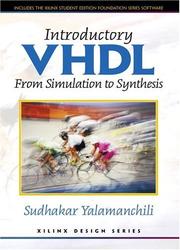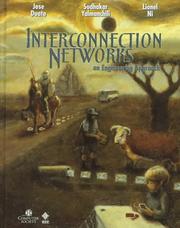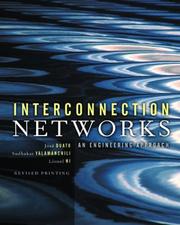| Listing 1 - 8 of 8 |
Sort by
|

ISBN: 0131457357 Year: 2005 Publisher: Upper Saddle River Prentice Hall
Abstract | Keywords | Export | Availability | Bookmark
 Loading...
Loading...Choose an application
- Reference Manager
- EndNote
- RefWorks (Direct export to RefWorks)
For schools that wish to introduce VHDL into their undergraduate computer engineering sequence, VHDL is a complex language that is worthy of a dedicated course; yet this is not a practical option in most institutions. This companion text enables instructors to integrate the basic concepts of VHDL into existing courses. It is designed to develop an intuition and a structured way of thinking about VHDL models without spending a great deal of time on advanced language features. Yalamanchili gives students a thorough grounding in the basic concepts and language of VHDL, and encourages them to apply what they have learned using realistic examples. Concepts are followed by examples and tutorials.
VHDL --- VHDL (vhsic hardware description language) --- Digitale systemen: ontwerp --- 681.3 --- vhdl --- hdl --- VHDL (vhsic hardware description language). --- Digitale systemen: ontwerp. --- VHDL. --- Very high speed integrated circuits --- VHDL (Computer hardware description language) --- Very High Speed Integrated Circuits Hardware Description Language (Computer hardware description language) --- VHSIC Hardware Description Language (Computer hardware description language) --- VHSIC --- Computer-aided design --- Computer hardware description languages --- Integrated circuits --- Computer simulation --- Very large scale integration --- 004.4

ISBN: 0130809829 Year: 2001 Publisher: Upper Saddle River Prentice Hall
Abstract | Keywords | Export | Availability | Bookmark
 Loading...
Loading...Choose an application
- Reference Manager
- EndNote
- RefWorks (Direct export to RefWorks)
VHDL (Computer hardware description language) --- fpga (field-programmable gate array) --- vhdl --- xilinx --- 681.3.066 --- Very High Speed Integrated Circuits Hardware Description Language (Computer hardware description language) --- VHSIC Hardware Description Language (Computer hardware description language) --- Computer hardware description languages --- Integrated circuits --- Computer science--?.066 --- Computer simulation --- Electronics --- Programming --- VHDL (very high speed integrated circuit hardware description language) --- simulaties --- programmeertalen

ISBN: 013519802X Year: 1998 Publisher: Upper Saddle River (N.J.) : Prentice-Hall,
Abstract | Keywords | Export | Availability | Bookmark
 Loading...
Loading...Choose an application
- Reference Manager
- EndNote
- RefWorks (Direct export to RefWorks)

ISBN: 9780131457355 Year: 2005 Publisher: Upper Saddle River (N.J.) Pearson Prentice Hall
Abstract | Keywords | Export | Availability | Bookmark
 Loading...
Loading...Choose an application
- Reference Manager
- EndNote
- RefWorks (Direct export to RefWorks)
Book
ISBN: 3540645713 3540693521 Year: 1998 Volume: 1417 Publisher: Berlin ; Heidelberg : Springer Verlag,
Abstract | Keywords | Export | Availability | Bookmark
 Loading...
Loading...Choose an application
- Reference Manager
- EndNote
- RefWorks (Direct export to RefWorks)
This workshop was a continuation of the PCRCW ’94 workshop that focused on issues in parallel communication and routing in support of parallel processing. The workshop series provides a forum for researchers and designers to exchange ideas with respect to challenges and issues in supporting communication for high-performance parallel computing. Within the last few years we have seen the scope of interconnection network technology expand beyond traditional multiprocessor systems to include high-availability clusters and the emerging class of system area networks. New application domains are creating new requirements for interconnection network services, e.g., real-time video, on-line data mining, etc. The emergence of quality-of-service guarantees within these domains challenges existing approaches to interconnection network design. In the recent past we have seen the emphasis on low-latency software layers, the application of multicomputer interconnection technology to distributed shared-memory multiprocessors and LAN interconnects, and the shift toward the use of commodity clusters and standard components. There is a continuing evolution toward powerful and inexpensive network interfaces, and low-cost, high-speed routers and switches from commercial vendors. The goal is to address the above issues in the context of networks of workstations, multicomputers, distributed shared-memory multiprocessors, and traditional tightly-coupled multiprocessor interconnects. The PCRCW ’97 workshop presented 20 regular papers and two short papers covering a range of topics dealing with modern interconnection networks. It was hosted by the Georgia Institute of Technology and sponsored by the Atlanta Chapter of the IEEE Computer Society.
Computer Science --- Engineering & Applied Sciences --- Parallel processing (Electronic computers) --- Computer networks --- Computer science. --- Computer memory systems. --- Microprocessors. --- Computer communication systems. --- Computer system failures. --- Algorithms. --- Computer Science. --- Computer Communication Networks. --- Processor Architectures. --- Memory Structures. --- System Performance and Evaluation. --- Algorithm Analysis and Problem Complexity. --- Congresses --- Memory management (Computer scie. --- Computer system performance. --- Computer software. --- Software, Computer --- Computer systems --- Informatics --- Science --- Algorism --- Algebra --- Arithmetic --- Computer failures --- Computer malfunctions --- Failure of computer systems --- System failures (Engineering) --- Fault-tolerant computing --- Computer memory systems --- Computers --- Electronic digital computers --- Storage devices, Computer --- Computer input-output equipment --- Memory management (Computer science) --- Minicomputers --- Communication systems, Computer --- Computer communication systems --- Data networks, Computer --- ECNs (Electronic communication networks) --- Electronic communication networks --- Networks, Computer --- Teleprocessing networks --- Data transmission systems --- Digital communications --- Electronic systems --- Information networks --- Telecommunication --- Cyberinfrastructure --- Electronic data processing --- Network computers --- Foundations --- Failures --- Memory systems --- Storage devices --- Distributed processing

ISBN: 0818678003 9780818678004 Year: 1997 Publisher: Los Alamitos (Calif.) : IEEE computer society press,
Abstract | Keywords | Export | Availability | Bookmark
 Loading...
Loading...Choose an application
- Reference Manager
- EndNote
- RefWorks (Direct export to RefWorks)
Computer networks --- Multiprocessors --- Computer networks. --- Multiprocessors.

ISBN: 1558608524 9786611071790 0080508995 128107179X 058545745X 9780585457451 9781558608528 Year: 2003 Publisher: San Francisco, CA : Morgan Kaufmann,
Abstract | Keywords | Export | Availability | Bookmark
 Loading...
Loading...Choose an application
- Reference Manager
- EndNote
- RefWorks (Direct export to RefWorks)
The performance of most digital systems today is limited by their communication or interconnection, not by their logic or memory. As designers strive to make more efficient use of scarce interconnection bandwidth, interconnection networks are emerging as a nearly universal solution to the system-level communication problems for modern digital systems. Interconnection networks have become pervasive in their traditional application as processor-memory and processor-processor interconnect. Point-to-point interconnection networks have replaced buses in an ever widening range
Computer networks. --- Multiprocessors. --- Information Technology --- General and Others --- Electronic digital computers --- Multiprogramming (Electronic computers) --- Parallel processing (Electronic computers) --- Communication systems, Computer --- Computer communication systems --- Data networks, Computer --- ECNs (Electronic communication networks) --- Electronic communication networks --- Networks, Computer --- Teleprocessing networks --- Data transmission systems --- Digital communications --- Electronic systems --- Information networks --- Telecommunication --- Cyberinfrastructure --- Electronic data processing --- Network computers --- Distributed processing

ISBN: 058545745X 9780585457451 9781558608528 1558608524 Year: 2003 Publisher: San Francisco, CA Morgan Kaufmann
Abstract | Keywords | Export | Availability | Bookmark
 Loading...
Loading...Choose an application
- Reference Manager
- EndNote
- RefWorks (Direct export to RefWorks)
The performance of most digital systems today is limited by their communication or interconnection, not by their logic or memory. As designers strive to make more efficient use of scarce interconnection bandwidth, interconnection networks are emerging as a nearly universal solution to the system-level communication problems for modern digital systems. Interconnection networks have become pervasive in their traditional application as processor-memory and processor-processor interconnect. Point-to-point interconnection networks have replaced buses in an ever widening range of applications that include on-chip interconnect, switches and routers, and I/O systems. In this book, the authors present in a structured way the basic underlying concepts of most interconnection networks and provide representative solutions that have been implemented in the industry or proposed in the research literature. * Gives a coherent, comprehensive treatment of the entire field * Presents a formal statement of the basic concepts, alternative design choices, and design trade-offs * Provides thorough classifications, clear descriptions, accurate definitions, and unified views to structure the knowledge on interconnection networks * Focuses on issues critical to designers.
| Listing 1 - 8 of 8 |
Sort by
|

 Search
Search Feedback
Feedback About UniCat
About UniCat  Help
Help News
News